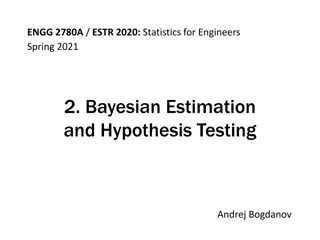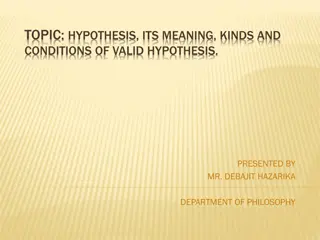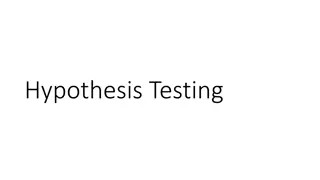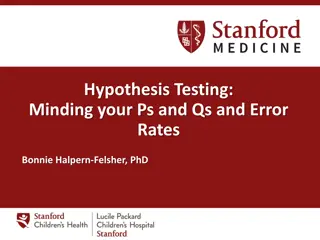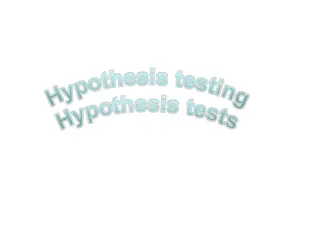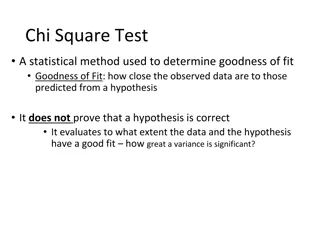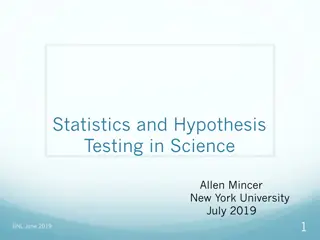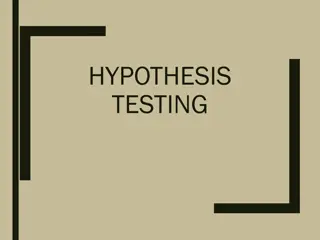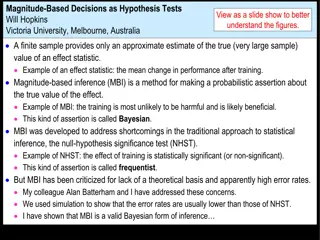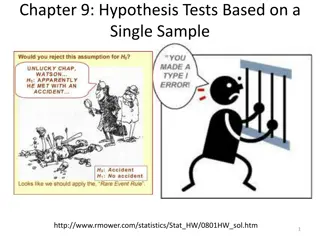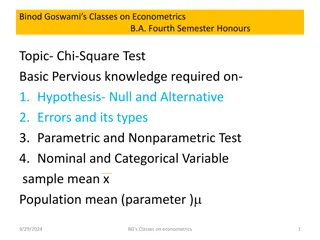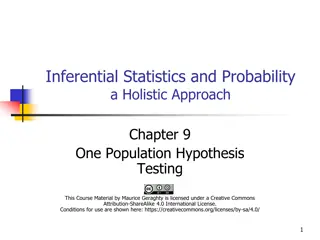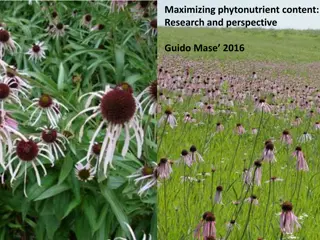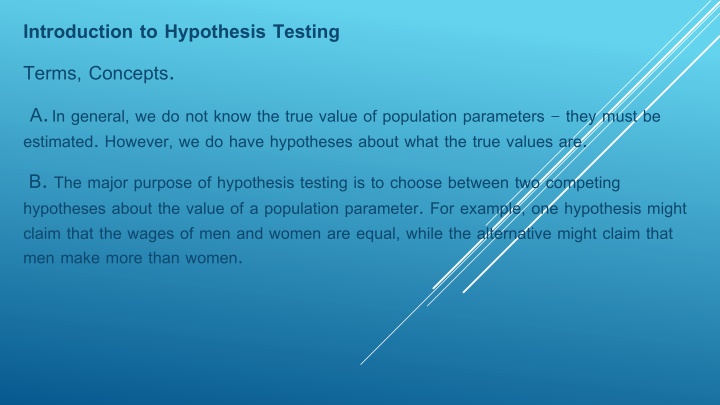
Hypothesis Testing Terminology and Concepts
Dive into the world of hypothesis testing to learn about null and alternative hypotheses, one-tailed and two-tailed tests, and how to determine the directionality of differences in population parameters.
Uploaded on | 1 Views
Download Presentation

Please find below an Image/Link to download the presentation.
The content on the website is provided AS IS for your information and personal use only. It may not be sold, licensed, or shared on other websites without obtaining consent from the author. If you encounter any issues during the download, it is possible that the publisher has removed the file from their server.
You are allowed to download the files provided on this website for personal or commercial use, subject to the condition that they are used lawfully. All files are the property of their respective owners.
The content on the website is provided AS IS for your information and personal use only. It may not be sold, licensed, or shared on other websites without obtaining consent from the author.
E N D
Presentation Transcript
Introduction to Hypothesis Testing Terms, Concepts. A.In general, we do not know the true value of population parameters - they must be estimated. However, we do have hypotheses about what the true values are. B. The major purpose of hypothesis testing is to choose between two competing hypotheses about the value of a population parameter. For example, one hypothesis might claim that the wages of men and women are equal, while the alternative might claim that men make more than women.
C. THE HYPOTHESIS ACTUALLY TO BE TESTED IS USUALLY GIVEN THE SYMBOL H0, AND IS COMMONLY REFERRED TO AS THE NULL HYPOTHESIS. AS IS EXPLAINED MORE BELOW, THE NULL HYPOTHESIS IS ASSUMED TO BE TRUE UNLESS THERE IS STRONG EVIDENCE TO THE CONTRARY SIMILAR TO HOW A PERSON IS ASSUMED TO BE INNOCENT UNTIL PROVEN GUILTY. D. THE OTHER HYPOTHESIS, WHICH IS ASSUMED TO BE TRUE WHEN THE NULL HYPOTHESIS IS FALSE, IS REFERRED TO AS THE ALTERNATIVE HYPOTHESIS, AND IS OFTEN SYMBOLIZED BY HA OR H1. BOTH THE NULL AND ALTERNATIVE HYPOTHESIS SHOULD BE STATED BEFORE ANY STATISTICAL TEST OF SIGNIFICANCE IS CONDUCTED. IN OTHER WORDS, YOU TECHNICALLY ARE NOT SUPPOSED TO DO THE DATA ANALYSIS FIRST AND THEN DECIDE ON THE HYPOTHESES AFTERWARDS.
E. IN GENERAL, IT IS MOST CONVENIENT TO ALWAYS HAVE THE NULL HYPOTHESIS CONTAIN AN EQUALS SIGN, E.G. H0: = 100 HA: > 100 F. THE TRUE VALUE OF THE POPULATION PARAMETER SHOULD BE INCLUDED IN THE SET SPECIFIED BY H0 OR IN THE SET SPECIFIED BY HA. HENCE, IN THE ABOVE EXAMPLE, WE ARE PRESUMABLY SURE IS AT LEAST 100. G. A STATISTICAL TEST IN WHICH THE ALTERNATIVE HYPOTHESIS SPECIFIES THAT THE POPULATION PARAMETER LIES ENTIRELY ABOVE OR BELOW THE VALUE SPECIFIED IN H0 IS A ONE-SIDED (OR ONE-TAILED) TEST, E.G. H0: = 100 HA: > 100 H. AN ALTERNATIVE HYPOTHESIS THAT SPECIFIED THAT THE PARAMETER CAN LIE ON EITHER SIDE OF THE VALUE SPECIFIED BY H0 IS CALLED A TWO-SIDED (OR TWO-TAILED) TEST, E.G. H0: = 100 HA: <> 100
I. WHETHER YOU USE A 1-TAILED OR 2-TAILED TEST DEPENDS ON THE NATURE OF THE PROBLEM. USUALLY WE USE A 2-TAILED TEST. A 1-TAILED TEST TYPICALLY REQUIRES A LITTLE MORE THEORY. FOR EXAMPLE, SUPPOSE THE NULL HYPOTHESIS IS THAT THE WAGES OF MEN AND WOMEN ARE EQUAL. A TWO-TAILED ALTERNATIVE WOULD SIMPLY STATE THAT THE WAGES ARE NOT EQUAL IMPLYING THAT MEN COULD MAKE MORE THAN WOMEN, OR THEY COULD MAKE LESS. A ONE-TAILED ALTERNATIVE WOULD BE THAT MEN MAKE MORE THAN WOMEN. THE LATTER IS A STRONGER STATEMENT AND REQUIRES MORE THEORY, IN THAT NOT ONLY ARE YOU CLAIMING THAT THERE IS A DIFFERENCE, YOU ARE STATING WHAT DIRECTION THE DIFFERENCE IS IN. J. IN PRACTICE, A 1-TAILED TEST SUCH AS H0: = 100 HA: > 100 IS TESTED THE SAME WAY AS H0: # 100 HA: > 100 FOR EXAMPLE, IF WE CONCLUDE THAT > 100, WE MUST ALSO CONCLUDE THAT > 90, > 80, ETC.

